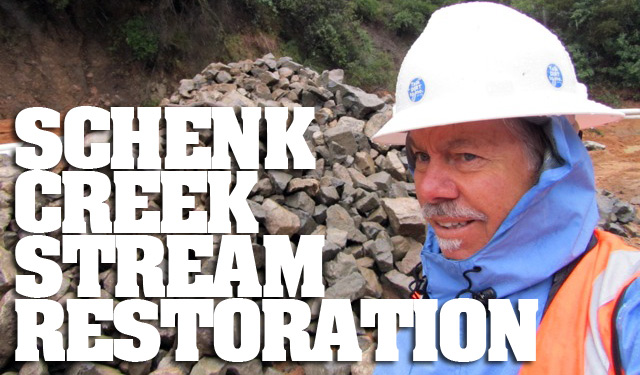27 May Update From The Road…
 Report from the Road – Schenk Creek Part 2
Report from the Road – Schenk Creek Part 2
San Bernardino National Forest
(note: Part 1 of this project’s blog post can be found here)
Well we finished up the HWY 330 Schenk Creek Stream Restoration today. The estimated 65,000 CY landslide from last winter has now been removed from the creek, and the highway stabilized and reopened. Its been a rough several months for the drivers who commute from San Bernardino to Big Bear Mountain Resorts and a potentially rough time for very critical yellow-legged frog habitat downstream. I believe that frog fate has been averted by the diligent and timely work of Caltrans and the other Resource Agencies involved, CDF&G, US Forest Service, US Army Corp of Engineers, and the US Fish and Wildlife Service
I pleased to say we got the work done (650 feet of channel) several days faster than I thought, but really experienced heavy equipment operators, once again, made the difference between a successful project and and “really great work”. We placed over 500T of rock to make the “roughened channel”, engineered riffles, about 300 ft of Longitudinal Stone Toe w/ Live Siltation, and some other innovative “biotechnical soil stabilization techniques” – Brushlayering /w geogrids and Soil Flapping (with 700g/m2 coir netting).
The overall strategy I came up with was revealed by looking up and down stream to see how the stream, prior to the landslide, functioned naturally – I often refer to Proper Functioning Condition (PFC)-type qualitative analysis. Then David Derrick and I both (at different times) identified some reference sites, showing that the stream utilized vegetated flood terraces (small because the canyon is steep and narrow) to store past sediment, brush and some large rock to dissipate energy. Even though this stream is seasonally dry, the flora is so very diverse and Willow plays an important part – most of the historic terraces were “held together” by an old willow bush, but sycamore, bay, and poison oak also had a part.
 it rained pretty hard last week, but good weather for willow cutting, collection and placing the Live Siltation in “wet” soil.
it rained pretty hard last week, but good weather for willow cutting, collection and placing the Live Siltation in “wet” soil. We also built a massive LST at the toe of the slide, great place for Live Siltation planted deep!
We also built a massive LST at the toe of the slide, great place for Live Siltation planted deep!
 Pic 4 – starting to build slope back up with coir roll and then brushlayering
Pic 4 – starting to build slope back up with coir roll and then brushlayering

 Soil Flap method os very constructable
Soil Flap method os very constructable





Yea! We’re Done with the stream, now Caltrans has to remove the access road and apply erosion control – More on those topics later!
It just so happens that Caltrans Office of Landscape Architecture is rolling out a NEW course Advanced Sustainable Erosion Control – For > 2:1 Slopes. It will present NEW tools including the RECP Soil Frap you saw here, RECP Soil Wrap, Brushlayering, Stepped Slopes, and more. Brent Hallock, Prof. CalPoly and myself are the instructors for this course being rolled out for Caltrans this June. Contact Dennis Cadd for more info.




